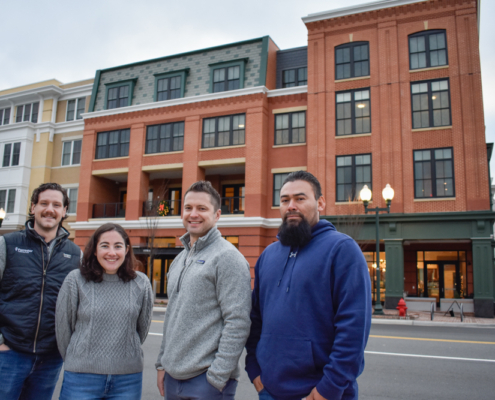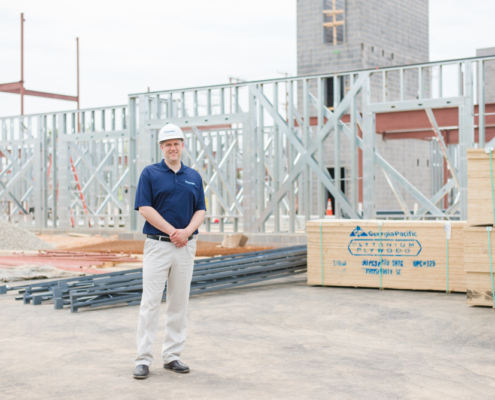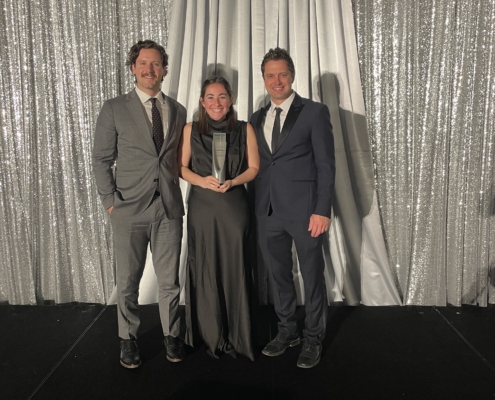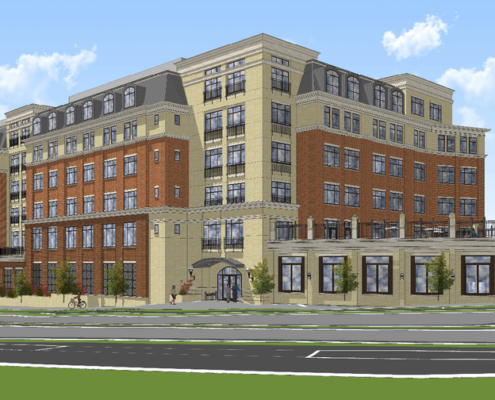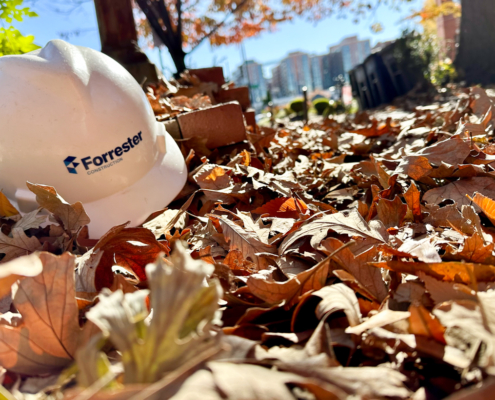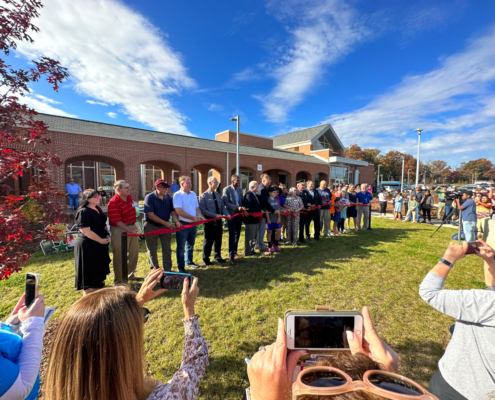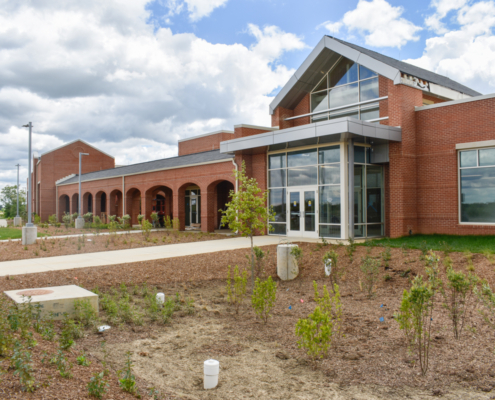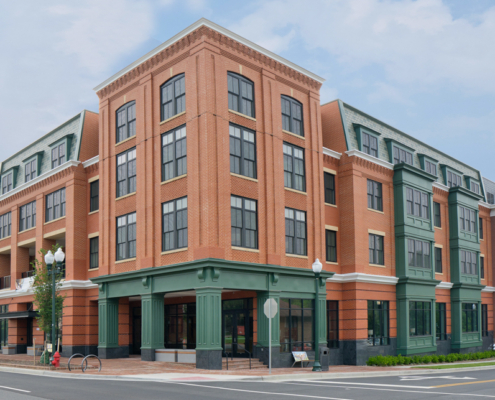2020 Industry Awards
FORRESTER KEEPS BUILDING AWARD-WINNING PROJECTS
Forrester Construction was honored with multiple industry awards this year. We are very thankful for the talent, passion, and dedication of our team, our clients for allowing us to turn their dreams into a reality, our design partners for their vision and creativity, and our subcontractors for their hard work and outstanding quality of craftsmanship. Forrester could not keep building award-winning projects without all of you!
Award: AGC of DC Washington Contractor Award
Project: Alethia Tanner Park
Client: NoMa Parks Foundation
Architect(s): Nelson Byrd Woltz (NBW), HNTB Architecture, and Studio 27 Architecture
Location: Washington, DC
Description:
The site of Alethia Tanner Park had previously been a railyard in Washington, DC. To transform this site into a beautiful new green space for the NoMa community, our work involved remediating the soil, getting it to a proper disposal center, and replacing it with healthy soil that became the base of the new lawn and landscaping.
The project features a half-acre turf lawn designed for community gatherings, summer movie screenings, informal sports, and passive recreation. A diverse array of trees, perennial landscaping, and bioretention facilities provide seasonal interest and help to define the different areas of the park. Our team utilized Silva Cells to plant trees that otherwise may not have been able to survive in the city environment. The Silva Cells have the added benefit of transforming the trees and the soil they grow into a powerful stormwater management system, absorbing and intercepting significant amounts of water and essentially creating an underground rain garden. We added native plants in the meadow, which will help to remove heavy metal contaminants from the soil over time. We also created four bioretention facilities that collect and store water for 48 hours, then slowly filter it into the stormwater management system.
The café and utility building feature Shou Sugi Ban siding, a Japanese method that torches the surface of the wood to protect and waterproof the material.
The Tanner Park playground features colorful poured in place surfacing, ropes, fireman poles, octagon platforms with slides, hanging bridges, a play-mound with rock climbing handholds, a walk-in kaleidoscope, and more.
The dog park features synthetic turf and pet platforms, which are unique to the United States but popularly used in Spain in plazas as a play and seating feature. Their rounded shape with flat surfaces makes these platforms look like large white pebbles against the green turf and black fencing that surrounds them and are features that pets and their owners can jump off and play around.
The project also features a large metal frame for projecting films, seating and picnic areas, and a wide meadow boardwalk with integrated seating. The site is complemented by new lighting, benches, movable tables and chairs, and bike racks.
An important component of this project involved upgrading and softening the S-curve on the Metropolitan Branch Trail at R Street NE, something area cyclists viewed as a key upgrade to a widely used trail. The realignment of the Metropolitan Branch Trail improves trail safety and navigability. In addition to softening the curve, our work included widening the existing trail, upgrading the lighting along the stretch of the trail adjacent to the park, and painting directional signage on the trail itself.
Award: ABC Virginia Excellence in Construction Award
Project: Patsy’s American, Best Buns, and Randy’s Prime Seafood and Steaks
Client: Great American Restaurants
Architect(s): Streetsense, Bowie Gridley Architects
Location: Falls Church, VA
Description:
This project was a complete demolition of an existing building and construction of multiple restaurant venues including a bakery, main dining, side dining, and two private dining spaces. A centralized kitchen, three bars, and patio seating were also constructed. At 23,929 square feet, this is one of the largest restaurants in the DC region. Each dining area is designed to be a distinct experience, with architectural details and finishes that are intended to reflect the menu and desired ambiance of the venue.
Patsy’s is a large, airy space with a casual, elegant feel; the design is intended to evoke a train terminal. Exposed brick, metal brick ties, and faux PVC beams with decorative steel stars under the roof trellises all suggest a terminal. One of the most striking features of the space is the soaring clerestory with a skylight made of Kalwall and framed by exposed steel beams. The room features vivid hand-painted murals, a large bar with more than 40 taps, and custom fabricated banquets with built-in millwork surrounds.
Randy’s is a formal environment, with a clubby and traditional feel. Herringbone style wood flooring surrounds the bar with calacatta gold marble. The ceilings are comprised of custom wood beams and lay-in acoustical panels. Guests enter through a foyer with custom marble flooring and are greeted by custom-built host stands of millwork and marble.
The back bar is more industrial, with a modern style featuring exposed ceilings, reclaimed wood floors, and a fully operational bifold door that opens the space to patio dining. The bar features floor to ceiling custom woodwork shelving with a rolling ladder to access the higher shelves.
The bakery is designed to evoke a French Creole feel, with extensive marble tiling, lighter wood, and large windows. Each dining venue is a distinct space, and all can be accessed through either interior or exterior doors.
Great attention was paid to the kitchen design because the client wanted a best in class kitchen. Cook lines were coordinated with architectural and structural curves. There is an upsized walk-in cooler to house all cold food prep operations. The space is highly functional, thoughtfully designed, and visually appealing.
The means and methods of building a 40’ tall building over an existing building footprint were challenging and managed through extensive collaboration between a variety of trades with over 35 subcontractors on-site. Forrester worked diligently to keep lines of communication open to avoid conflicts and get the job done. Walking into the space, the quality truly speaks for itself.
Forrester worked tirelessly with the owner throughout an evolving design process to deliver a building that exceeded their expectations and is the jewel in the Great American Restaurant Group’s crown.
Award: AIA Maryland Excellence in Design Award
Project: McLean School Addition/Renovation
Client: McLean School
Architect(s): Quinn Evans Architects
Location: Potomac, MD
Description:
The McLean School is a K–12 college preparatory school located in Potomac, MD. Forrester was selected for the renovation of the campus and to build a second story addition. The work was completed while the school remained fully occupied and operational. The second-floor addition was built over the existing facility and provided the school with new hallways, classrooms, and a student lounge. The new classrooms include a soundproof music room and recording studio, a large dividable presentation room, and a laboratory for the school’s STEM program. A new entry vestibule was also built with large windows to let in natural light and a dynamic staircase to connect the second floor to the existing main entry.
Existing spaces on the first floor were renovated to accommodate a new steel structure and new support columns were installed to support the second-floor addition. New HVAC, and sprinkler systems were installed, and the fire systems were modified. The existing library received updated carpets, benches were built in the hallways, and two live plant walls were installed in the main entrance.
As with any extensive renovation, this project required innovative problem solving. To build the second level to be structurally self-sufficient, we cut a hole in the existing roof to drop steel into the building. After securing the steel, the roof had to be resealed. This method allowed for minimal disruption to the existing structure while adding the appropriate support for the new second story addition.
The safety of students was of the upmost importance during the duration of this project. The team played close attention to scheduling activities with high inherent risk, like using a crane to erect steel, during the summer when students were off campus. When students arrived back to campus during ongoing construction, sequencing work appropriately and with open communication to the school was vital. The team utilized signage, fencing, and windscreen to separate the school community from the construction area. Areas off-limits were clearly delineated and marked. Deliveries were carefully coordinated around bus schedules, drop off, and pick up to ensure safe arrival and departures for students and their families.
Award: NAIOP MD | DC Award of Excellence
Project: St. Thomas’ Parish
Client: St. Thomas’ Episcopal Church
Owner: Clear Real Estate Services
Architect(s): Hickok Cole Architects
Engineer(s): Metropolitan Engineering, Inc.
Location: Washington, DC
Description:
St. Thomas’ Parish is a 4.5 story church built in Washington, DC, sharing an underground garage and demising wall with a market rate rental property. The church’s contemporary design distinguishes it from the neighborhood while elements from the original 1899 structure were incorporated into the new facility to honor the past.
This church’s contemporary look stands out from the neighborhood. The project features the use of a complex terracotta rainscreen system that is atypical for this region and a green roof. A full height light tower clad in terracotta and curtain wall at the front of the building provides light for every floor, including the spacious upstairs sanctuary and doubles as an energy saving feature for the church.
The interior fit-out consisted of the elevator lobby and four floors above grade. The first floor includes a lobby, chapel, and offices. A two-story sanctuary serves as the primary worship space on the second floor; an organ and choir loft are featured at the mezzanine level and the remaining floors house a fellowship hall, kitchen, and terrace. Ascension stairs lead from the ground floor to the sanctuary and fellowship hall. The finishes feature acoustical ceilings, large format tile and acoustic paneling, significant ornamental metal work that includes the feature tower and cross, and stained-glass elements.
It was important to the client that the church’s history and past be honored within the contemporary design. Facade elements from the original 1899 church were deconstructed, cataloged, cleaned, preserved, and then reinstalled in the entry vestibule. The scope included fabricating some new stone elements to ensure that the ruins would fit in the new space, as well as replacing stones which could not be recovered.
Working on a split-building site in a highly occupied area required coordination on many levels. Shared laydown and delivery areas were identified, and Forrester approached working with the other general contractor as partners. Our teams communicated daily, collaborated on the timing of deliveries, and determined access to areas of the site daily. The building is set in a busy Dupont Circle neighborhood that includes homes, businesses, and embassies. Forrester collaborated with the community to minimize negative impact from construction by limiting work hours, making sure work lights did not shine into neighboring buildings, and opening sidewalks and alleyways to the community as quickly as possible. In addition, the team worked tirelessly to achieve substantial completion two weeks early to fulfill the client’s hope that Easter service could be held in the new sanctuary.
The building reflects a perfect blend of the past and present. The incorporation of the historic ruins, the exceptional modern finishes within the space, and the contrasting tile and terracotta on the façade all seamlessly achieve the client’s vision for the new church.
Award: NAIOP Northern Virginia Award of Excellence
Project: Bailey’s Shelter and Supportive Housing
Client: Fairfax County Department of Public Works
Architect(s): LeMay Erickson Architects
Location: Falls Church, VA
Description:
The new shelter is a vital part of Fairfax County’s Office to Prevent and End Homelessness’ 10 Year Community Plan to Prevent and End Homelessness. The shelter not only serves the County’s homeless population but also fills a great need in the community by providing long term supportive housing, an emergency hypothermia shelter, medical services and other supportive care in a single location.
“The new Bailey’s Shelter and Supportive Housing is designed to serve our homeless neighbors with dignity by meeting multiple needs at one location. It will provide both emergency shelter for those seeking help during difficult times, as well as permanent housing combined with supportive services for our most vulnerable residents. This is the first of its kind in Fairfax County and we hope it serves as an example of how we can all work together to solve our most pressing challenges and make a real difference in our neighbors’ lives.” Dean Klein, Director of the Office to Prevent and End Homelessness.
This project involved the construction of a cellar and sunken plaza and three floors above grade. The shelter was built to accommodate 52 emergency shelter beds including 4 medical respite beds, living quarters for 18 persons, staff offices, and an outdoor picnic and activity area. The work included interior construction to accommodate housing and common area uses such as assembly rooms, showers, restrooms, a kitchen, office and support spaces.
The site is approximately one-half acre. Site work consisted of concrete paving for drive aisles and 25 parking spaces, a stormwater management underground vault, related site accessories, landscaping and various utility improvements.
Learn more about our capabilities and how we can help you realize your vision.

